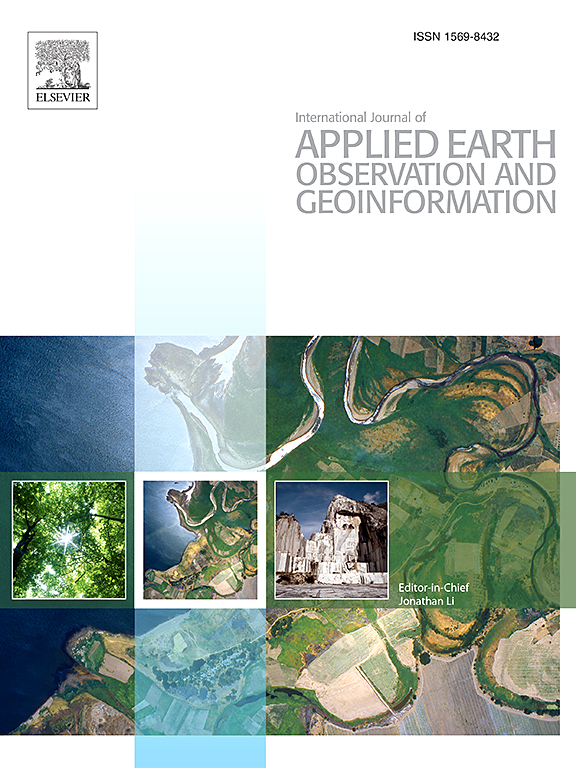National-scale tree species mapping with deep learning reveals forest management insights in Germany
IF 7.6
Q1 REMOTE SENSING
International journal of applied earth observation and geoinformation : ITC journal
Pub Date : 2025-04-27
DOI:10.1016/j.jag.2025.104522
引用次数: 0
Abstract
Accurate tree species distribution is essential for biodiversity assessment, sustainable forest management, and environmental policy. However, mapping species over large areas with satellite data is challenging due to spectral mixing and complex spatial distribution. To address this, we developed a novel deep learning model, ForestFormer, using Sentinel-2 time series data to map eight dominant tree species in Germany. ForestFormer’s dual-branch network with spectral and spatial attention modules improves classification by highlighting species-specific characteristics. Cross-validation in 2,364 National Forest Inventory plots shows that ForestFormer achieves species classification accuracy ranging from 69% to 92%, with an average accuracy of 84%, outperforming existing baseline methods. The developed ForestFormer model can help generate a large-scale and reliable tree species map for Germany, which in turn provides crucial insights into the diverse characteristics of tree species to support forest management. Our analysis of results shows that Pine is the species most resistant to disturbances, while Douglas fir is the least. Northeastern regions of Germany exhibit particularly low levels of forest biodiversity, especially in the states of Brandenburg and Berlin, followed by neighboring states such as Sachsen–Anhalt, Mecklenburg–Vorpommern, Sachsen, and Niedersachsen. In addition, climatic factors, especially water deficit, are shown to play a very important role in determining tree species distribution patterns, followed by topographic and soil factors. These findings are anticipated to provide a critical basis for environmental policy formulation, particularly in forest management strategies responding to ongoing climate change.
用深度学习绘制国家尺度的树种图,揭示了德国森林管理的见解
准确的树种分布对生物多样性评估、可持续森林管理和环境政策至关重要。然而,由于光谱混合和复杂的空间分布,利用卫星数据绘制大面积物种地图具有挑战性。为了解决这个问题,我们开发了一种新的深度学习模型ForestFormer,使用Sentinel-2时间序列数据绘制了德国8种主要树种的地图。ForestFormer的双分支网络具有光谱和空间关注模块,通过突出物种特有的特征来改进分类。在2364个国家森林清查样地的交叉验证表明,ForestFormer的物种分类准确率在69% ~ 92%之间,平均准确率为84%,优于现有的基线方法。开发的ForestFormer模型可以帮助为德国生成大规模和可靠的树种地图,从而提供对树种多样性特征的重要见解,以支持森林管理。我们的分析结果表明,松树是最能抵抗干扰的树种,而花旗松是最不能抵抗干扰的树种。德国东北部地区的森林生物多样性水平特别低,特别是在勃兰登堡州和柏林,其次是邻近的萨克森-安哈尔特州、梅克伦堡-前波莫瑞州、萨克森州和下萨克森州。此外,气候因子,尤其是水分亏缺对树种分布格局有重要影响,其次是地形因子和土壤因子。预期这些调查结果将为环境政策的制定,特别是对正在发生的气候变化作出反应的森林管理战略提供重要的基础。
本文章由计算机程序翻译,如有差异,请以英文原文为准。
求助全文
约1分钟内获得全文
求助全文
来源期刊

International journal of applied earth observation and geoinformation : ITC journal
Global and Planetary Change, Management, Monitoring, Policy and Law, Earth-Surface Processes, Computers in Earth Sciences
CiteScore
12.00
自引率
0.00%
发文量
0
审稿时长
77 days
期刊介绍:
The International Journal of Applied Earth Observation and Geoinformation publishes original papers that utilize earth observation data for natural resource and environmental inventory and management. These data primarily originate from remote sensing platforms, including satellites and aircraft, supplemented by surface and subsurface measurements. Addressing natural resources such as forests, agricultural land, soils, and water, as well as environmental concerns like biodiversity, land degradation, and hazards, the journal explores conceptual and data-driven approaches. It covers geoinformation themes like capturing, databasing, visualization, interpretation, data quality, and spatial uncertainty.
 求助内容:
求助内容: 应助结果提醒方式:
应助结果提醒方式:


